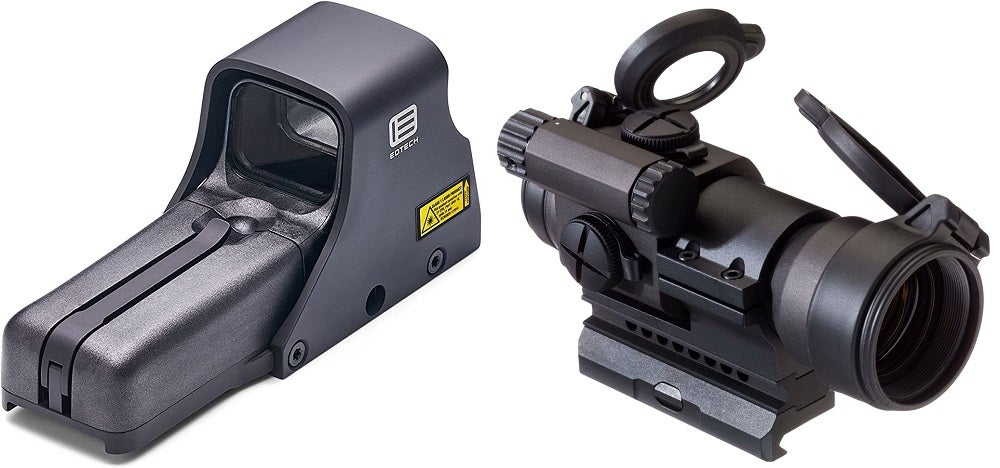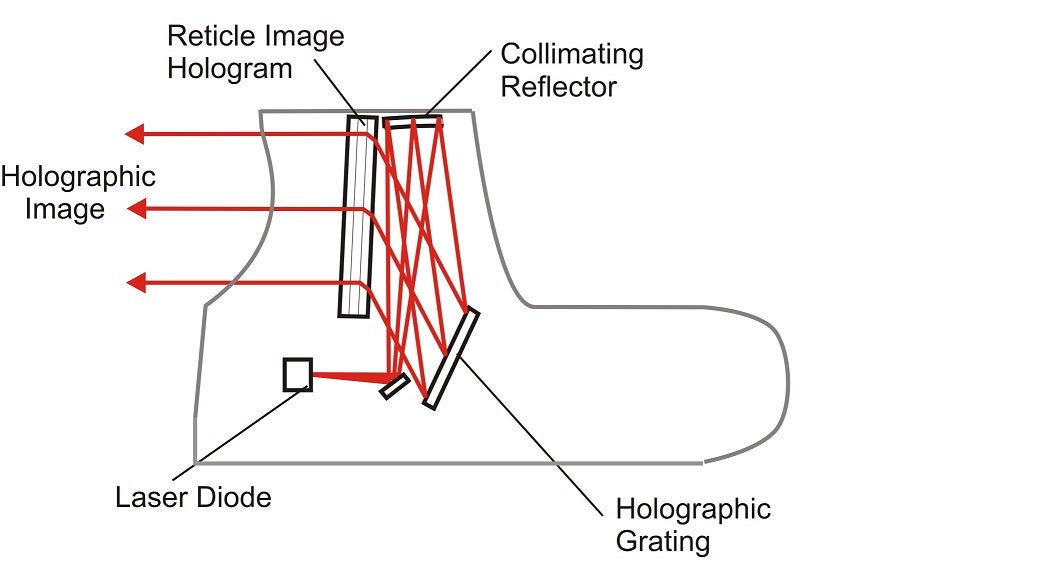Red Dots vs. Holographic Sights: What’s The Difference? Which is Better?
Travis Olander 06.29.23

Holographic sights, like the EOTECH XPS2, are lauded for their accuracy and reliability. Red dots, like the new solar-powered SCRS from Holosun, are just as popular thanks to their cost and performance. What, exactly, is the difference between a red dot and a holographic sights though? What are reflex sights, for that matter? Let’s clear it up and talk through the pros and cons of each optic.
How Do Holographic Sights Work?
Holographic sights get their name from one key component of the optic itself: The image hologram. The hologram lens physically “holds”, or contains, the aiming reticle. In keeping the explanation simple, think of a film projector. A single beam of light is focused by a lens, then shone through a piece of semitransparent film holding an image. That image is carried by light to a screen. The image is, technically speaking, now a physical object located in three-dimensional space, held by the projector screen.
A holographic sight works practically the same way: in this case, the projector beam is a laser diode. The laser beam is directed through a special reflector called a collimator, which separates the beam into individual, smaller beams. Think of the collimator as the projector lens. Finally, a special piece of glass called a holographic grating aligns the individual laser beams, and reflects those onto a final piece of glass: the reticle image hologram. The hologram, in this case, is our projector screen.
What is the Benefit of a Holographic Reticle?
The holographic sight produces what is essentially a three-dimensional object of light – the reticle – physically held in space. This provides some key advantages for human eyesight.
Minimal parallax error. In lay terms, parallax error occurs when an aiming reticle appears to move in space relative to the target due to the position of your eye. This is because the focal length of the target and the glass within the reticle are not the same. Holographic sights significantly reduce this error by the very nature of their reticle’s presentation.
It’s a common misconception that holographic sights have zero parallax error, which isn’t true. Any optic that relies on any sort of focused lens will have some measure of parallax. But for practical aiming distances and accuracy, a holographic sight needs no parallax correction.
What does this mean? That means your eye and head position, relative to the reticle itself, doesn’t matter. Point of aim and point of impact will always match up regardless of whether you’re shooting standing, kneeling, or prone with poor cheek weld or otherwise poor positioning. This translates into faster target acquisition and more consistent accuracy.
Open-eye aiming. Because the reticle doesn’t require a specific focal length relative to the target you’re aiming at, you can easily aim with both eyes open. This provides a critical tactical advantage. It also reduces eye strain while provides greater situational awareness.
Wide field of view. Holographic sights don’t require a particular concav or convex hologram lens. That allows the sight to use a flatter, wider, and taller piece of glass containing the reticle, which means you’ll enjoy a wider field of view with lens mechanical obstruction from the optic itself.
How Does a Red Dot Sight Work?
Red dot sights are infinitely simpler than holographic sights, implied by our somewhat crude illustration above. Red dot sights, which are also commonly called reflex sights (they are one and the same), use just a single piece of glass to provide the shooter with a viewable reticle. Instead of using a laser diode, red dots use LEDs (light-emitting diodes).
Relying on our projector analogy, the red dot sight requires your eye to act as the “screen.” Where the holographic sight’s reticle is held inside a hologram lens, your eye is the lens that the reticle is projected onto. The LED forms the reticle near the source of light: Instead of relying on collimator and grating lenses to separate the light into beams, a simple template placed atop the LED shapes the light to form the reticle. Think of Batman’s classic bat signal in the sky. This shaped beam of light is reflected off a convex lens directly at the shooter’s eye.
What is the Benefit of a Red Dot Sight?
Naturally, this level of simplicity – relative to the complex machinations of a holographic sight – lend some advantages to the shooter.
Red dots are also nearly parallax-free. Although they’re slightly more susceptible to this focal plane error due to their convex lenses, red dot sights provide minimal parallax error when aiming at practical distances. Like holographic sights, this translates into quick targeting and consistent point of aim and point of impact, regardless of your position behind the optic.
Red dots are simpler, smaller, and cheaper. LEDs and single lenses are cheap and easy to manufacture. The simple design of the typical red dot sight means it’s typically smaller, lighter, and more affordable than a holographic sight. Where the “cheapest” EOTECH starts at around $450, a quality reflex sight from a reputable brand (like Bushnell, Aimpoint, Burris, Vortex, or Holosun) can be found for less than half that price.
Red dots run forever. Modern LED technology is pretty remarkable. Most red dot sights can operate continuously, on medium power, for literally years. In fact, the typical reflex sight advertises an always-on runtime of more than 100,000 hours (that’s over 11 years). For comparison, the average EOTECH will run between 600 and 2,500 hours (roughly 25 to 100 days).
So, Which Optic is Better?
This writer’s worked with optics for well over a decade, to include running an EOTECH (512) and Aimpoint (CompM4) on service rifles in the military. It’s my opinion that the EOTECH 512 provided just one minor advantage, and that was offering a wider field of view. However, the 512 also appeared to suffer some measure of “drift” in its reticle in extreme temperatures. I also qualified 40/40 more than once using the CompM4.
Modern, open red dot sights that ditch the “tube-style,” two-lenses setup also now afford a similar field of view when compared to holographic sights. Red dot sights are more affordable, they’re smaller, lighter, and simpler, and they practically never require battery changes. I think the average shooter should invest in a red dot instead of a holographic sight.

